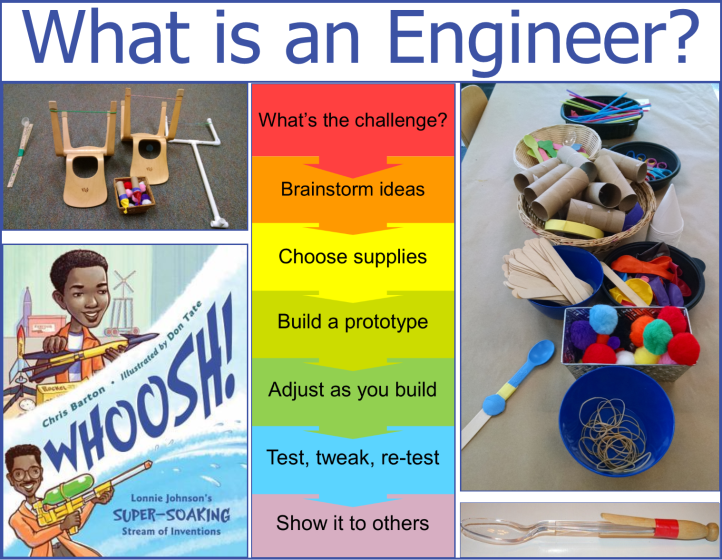
During our 11 week engineering unit, we study Simple Machines, Electricity, Ways to Build Tall Structures and Strong Structures, Building Houses and Cars and Contraptions. We begin the unit by discussing the engineering process.
The Big Idea
We explain that the engineering process starts when someone sees a problem that they want to solve, or sees something that could work better than it does. They brainstorm ideas for what they could do, given the supplies that they have. Then they start building – they make a prototype. They test it – does it solve the problem and meet their goals? How could it be better? They refine and test again.
Overview of Activities
Our challenge activity was to design a tool to launch a pompom into the air (our ideas included a balloon popper, pompom puffer, pompom plunger and a spoon on a clothespin). Our craft was a paper bag kite. We did several tinkering activities during free play: ball walls / marble runs, ramp play, and a wind tube. During circle, we learned about the engineering process with a song, then read a book about an inventor. At the bottom of the post, you’ll find extension activities and recommended kids’ videos about engineering.
The Challenge – Launch a Pompom
We have lots of materials on the table, and we have four prototypes that they can test out. They can choose to build one of those, or create any other design from the materials available.
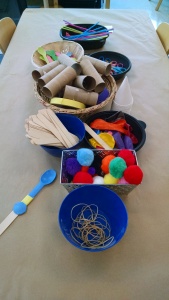
Our 3 year old students tend to pick one design and their parents help them build it. Our 5 year olds may try out a couple of designs with the assistance of a parent or teacher. Our 7 year olds (who have typically been in the class in a previous year) tend to get creative. Once they’ve built it, they get to play with it for a while. (Lots of giggles when pompoms bounce off the ceiling or fly all the way across the room.)
Then, we challenge them to refine their launchers. We offer some goals: could you make it launch more than one pompom at a time? How could you make it launch the ball further? Can you hit that target – if not, how could you make your launcher more accurate? They can choose to tinker and refine as much as they want to.
The supplies we provide: plastic spoons, rubber bands, clothespins, TP rolls, balloons, popsicle sticks, snow cone cups, straws, scissors, tape, paper. (If their design idea requires a material that’s not out on the table they can ask a teacher to get that material for them.)
Here are our four prototypes:
Balloon Poppers (aka Marshmallow Shooters)
Just tie a balloon (no need to inflate it), then cut off the rounded end and stretch that opening over the end of a toilet paper tube. That’s it…
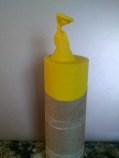
To use: Hold it with the open end of the tube facing up. Load it with a marshmallow, pompom or whatever, then pull down on the balloon knot and release to launch it. The pompom will likely hit the ceiling. Optional: if you find your balloon is pulling off of the tube when you pull on it, just tape it in place.
Variations: On Coffee Cups and Crayons, she describes doing this with a cake pop container. Paging Fun Mums uses a plastic cup with the bottom cut off. On Frogs and Snails, she uses a pool noodle, which would be good for little ones who might crush the toilet paper tube by holding too tight. I prefer using the biodegradable TP tubes.
Pompom Puffers
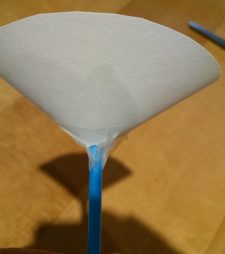 Cut a circle from cardstock, cut a small hole in the center, roll it into a cone shape, and tape to a bendy straw. Then you set a pompom in the cone, and blow through the straw, trying to keep the pompom afloat in the air over the cone without escaping. (I got the idea online, and I try to always credit my sources, but I lost track of where this idea came from. 😦 If you know, please note source in the comments!) Here is a PDF with my directions and a template for the circle. Or, if you have Sno-Cone Cups, you can use those instead of building a cone – you just snip off the very tip of the cone, then tape it on the straw.
Cut a circle from cardstock, cut a small hole in the center, roll it into a cone shape, and tape to a bendy straw. Then you set a pompom in the cone, and blow through the straw, trying to keep the pompom afloat in the air over the cone without escaping. (I got the idea online, and I try to always credit my sources, but I lost track of where this idea came from. 😦 If you know, please note source in the comments!) Here is a PDF with my directions and a template for the circle. Or, if you have Sno-Cone Cups, you can use those instead of building a cone – you just snip off the very tip of the cone, then tape it on the straw.
Spoon on a Clothespin
Take a plastic spoon. Insert it into an old-fashioned clothespin, tape it tightly. To use: put a pompom in the spoon. Hold it in place with one hand while you hold the clothespin in front of you with the spoon at top, facing away from you. Pull the spoon back, and let go. Alternate: you can also tape the spoon onto a jumbo craft stick.

Pom Pom Plunger
This is just a piece of paper folded and taped. You pull down the plunger, load the pompom and then push the plunger up to launch. Check out the tutorial at https://inventorsoftomorrow.com/2021/10/18/pompom-plunger/
You could also offer craft stick catapults as an option. The only reason we don’t is because we’ll be building them a few weeks later in our Levers class.
Large Launchers
In our active play area, we also have some large-scale pompom launchers we have built for them to explore. We built them with chairs, PVC pipes, rubber bands and bungie cords, then mounted targets on the wall to aim at. (Optional: you can tie these in to an Angry Birds theme where you launch balls to knock over towers of toilet paper tubes, plastic cups, or whatever.)
We’ve also built the indoor slingshot / balloon popper gun from Design Squad or Frugal Fun.
Craft – Paper Bag Kites
We chose this activity for two reasons – it ties into our book about inventor Margaret Knight, and it was a good tie-in to the next week, when we would study Wind and Flight.
Find directions at Kinder Art, Sophie World, or Somewhat Simple.
Sorting – Natural or Engineered
We offer a sorting activity where they sort things into: “found in nature” or “made by a human.” Sometimes we just have it set up on a table for the child to do on their own, sometimes we do it in group time – holding up items and asking them which category it’s in. For some of the “made by a human” we ask – why was it made? What job does it do? What problem does it solve? For 3 – 4 year olds, you should be pretty obvious with items. With older kids, be tricky – for example, beach glass is made by a human but then shaped by nature and polished stones are found in nature but then polished by humans.
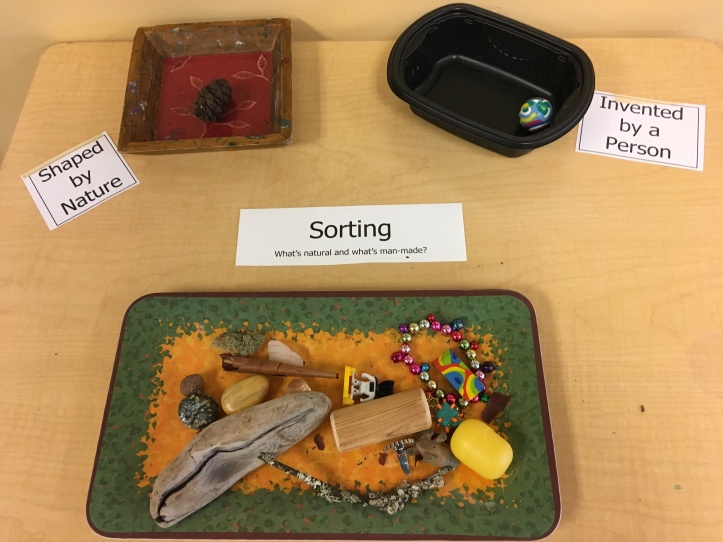
Free Play Tinkering
We also had several free play activities that encourage tinkering. The child can arrange things one way, test it, re-arrange it and test it again. We had:
- marble runs – those things where you line up the tracks in a wide variety of ways and run a ball down them, then adjust the tracks and run it again to get the longest run, fastest run, most dramatic run, or whatever. These are one of the best possible engineering toys for learning the tinkering mentality, while also learning about gravity and inclined planes. We had our homemade ball wall from PVC pipes, our Tumble Trax
, and a plastic pipe style marble run
- Kodo Kids ramps for ramp play… they build ramps, roll balls down, then re-design the ramp to achieve challenge goals – like roll the ball the furthest, roll the ball so it hits this target, and so on
- The wind tube. It’s a clear tube mounted above a fan. When you place really lightweight things in the tube, like a scarf, they blow right out the top. If you place a heavy thing, it sits on the fan. The most fun are the mid-weight items – the plastic ball that’s too heavy to float, but will roll round and round in circles on the fan, or the paper cup that will float a few feet up but never quite escape the tube. It’s a great deal of fun to play with for everyone from toddlers to adults. (learn more about wind tube play and how to build a wind tube)
Math Activity – Pattern Machine
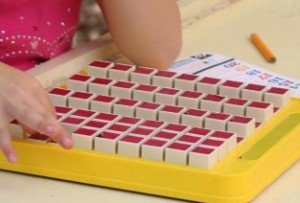 There’s a great website called Talking Math with Kids. He used to sell a product called the Pattern Machine. You press the button and it pops up. Press it again and it stays down. (You can make your own by taking a multiplication machine
There’s a great website called Talking Math with Kids. He used to sell a product called the Pattern Machine. You press the button and it pops up. Press it again and it stays down. (You can make your own by taking a multiplication machine and covering the numbers with stickers.) This activity is fun for even little kids to do, and it good for fine motor skill building. But it’s also a mathematical thinking tool. Kids use it to create and recognize patterns, which just seems like fun to them, but is also training the brain. They may try something like all buttons up, or every other button up, or all the buttons in every other row up, or all the buttons on the outside edges up or they might use it to make letter or number shapes with. Any way they use it is fine with us – it’s a process oriented activity.
At the sensory table, we built an apparatus from cardboard and styrofoam to pour brown rice over and through. At the water table, we made a PVC frame that we hung funnels from.
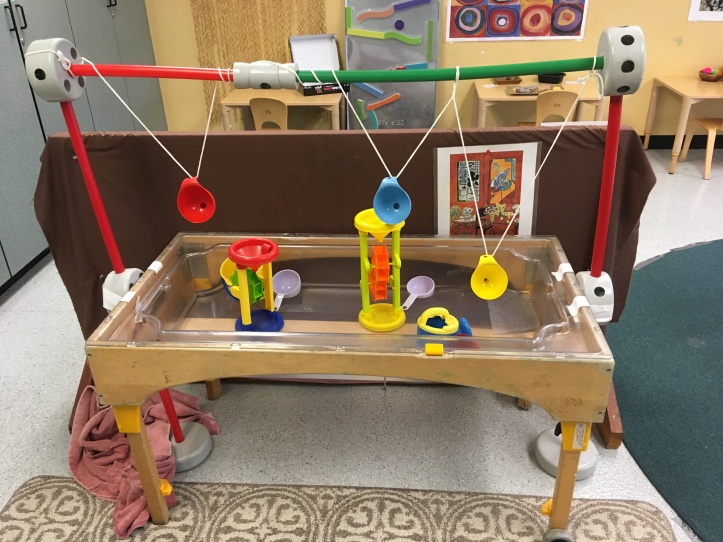
Circle Time
Theme Discussion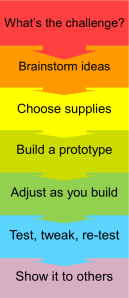
We ask: What’s an engineer? Why do they build? Discussion leads to the answer that engineers see problem they want to fix, or something that could be improved. (Or they think of something that would be really fun to have.) They take on the challenge of building it.
Talk about Tinkering / the Engineering process – they brainstorm ideas for what they could do, look around to see what supplies they have available to them that might work, build a prototype (and as they build, they usually get more ideas and adjust their original design. Then they test it – does it work? does it solve the problem? They fix it (“tweak” it) till it works just right, and then show it off.
You could either use the challenge activity as an example of this, or you could show them a project you wanted to work on and the problem-solving process you went through. Or, if you’re reading Whoosh, you could show them an old style squirt gun that only holds a few squirts worth of water before needing re-filled, and talk about how you could re-design it.
Inventors’ Lab Theme Song
We have a song we wrote which walks kids through all the steps in this process. “There’s a challenge that I want to do. Way-hey, building and inventing. Here’s the process that I will go through – here at Inventor’s Lab.” You can find the words in my post about Kids’ Songs about Inventing.
[Note: there are other ways to break the process down into steps: EIE curriculum (see resources) describes a 5 step process: Ask, Imagine, Plan, Create, Improve. Or their Wee Engineers is simply: Explore, Create, Improve. NAEYC has Find a Problem, Imagine & Plan, Create, Improve.]
Book
Izzy Gizmo. (YouTube read-aloud.) This is my favorite fiction book for this class – a Black girl likes to invent, and her grandfather supports her, even as she makes MANY messy mistakes. Her compassion leads her to help an injured bird to fly again. (We do a wind and flight theme the week after this, which makes this the perfect book for us!)
Another option is Albert’s Alphabet (video) which shows how sometimes when you run out of supplies, you have to be really creative.
For non-fiction:
Whoosh!: Lonnie Johnson’s Super-Soaking Stream of Inventions which is a story about a Black inventor and starts with him as a boy excited by science and inventions. He faces challenges, some due to race, but becomes a NASA scientist and inventor. It’s also about a fun product that they may have had a chance to interact with. You could also share this video about Lonnie Johnson.
Another good biography to consider is Marvelous Mattie about Margaret Knight. I like that it tells some history, it features a female inventor, and it starts with her inventing as a child. The main invention it describes is the flat bottomed paper bag, so I do a demonstration to show why this bag is so much better than the flat bag it replaced. Read more about the Marvelous Mattie book.
Check out my post on 100 Kids’ Books about Engineering for more ideas.
Try it At Home project
I give parents a few ideas to try at home. Or, you could choose to use these in-class.
- “Inventing a new kind of pencil” – (you could also use this as model for doing an object other than a pencil): http://www.uastem.com/wp-content/uploads/2013/01/Pencil-Innovation-Challenge.doc
- Or work on a pet invention.
- Or build a letter of the alphabet that stands up by itself.
- Or design an object that can be pushed or pulled with magnets.
- Or ask kids what they have a hard time doing. Have them brainstorm / draw an invention to solve that problem.
Videos
I give parents suggestions for videos they could use to preview or review the class content. For this topic: For 3 – 4 year olds, “Sid the Science Kid Engineers a Solution” – about 20 minutes long. For 5 – 7 year olds: “Jessi has a problem” from Sci Show Kids https://www.youtube.com/watch?v=RM04n0-QtNo OR “What’s an Engineer” from Crash Course Kids https://www.youtube.com/watch?v=owHF9iLyxic. These are both short – maybe 5 minutes each?
If you have access to the Mystery Science curriculum: What is an inventor video: https://mysteryscience.com/mini-lessons/inventions#slide-id-9535
Resources for Engineering Curriculum
The Museum of Science – Boston has created the Engineering is Elementary curriculum and Wee Engineer for preschoolers and has helpful resources on their site. (Judging from their videos, these are definitely classroom lecture-based models, which is very different from the get-their-hands-on-a.s.a.p. process that I follow in my classes. But there’s lots of good stuff there.)
Children’s Engineering Educators offers free resources of their own, and links to other helpful resources.
NAEYC has a nice overview article on Engineering Practices in Preschool.
Note: All the activities described in my posts are from Family Inventor’s Lab, a parent-child cooperative class in Bellevue, WA. We are a play-based, STEM focused class for preschool through early elementary (kids age 3 – 7). We do a wide variety of fun, hands-on activities to learn about Science, Tools, Engineering, Nature, and Art. We also sing songs and read stories. Most of our activities are cheap, easy, and use everyday materials that most families would have in their homes (or their recycle bins!), so that our activities are appropriate for classroom teachers, parents who homeschool, or after school programs. There are some affiliate links to Amazon in the post above – if you click on any of those and then order something on Amazon, I do get a small cut of their proceeds.




[…] In our Inventors Lab class, we use the book Marvelous Mattie: How Margaret E. Knight Became an Inventor by McCully when we talk about Inventors and Engineers. […]
LikeLike
[…] that act as “tendons” for our cardboard fingers. We blow through bendy straws for our pompom puffers and our ballast submarines. We use straws in our lung models. And we’ve used them to blow air […]
LikeLike
[…] to start by talking about what I mean by engineering: I think of it as hands-on problem-solving. Engineering is about seeing a problem, coming up with ideas for how to fix it, testing them out, and revising […]
LikeLike
[…] is an Inventor? or What is an Engineer? Provide some kind of “invented food.” For example, instead of fresh blueberries, a […]
LikeLike
[…] often offer a “weekly challenge” activity where children have a chance to practice the Engineering Process (aka Tinkering) – see a challenge you want to solve, collect data and examine available […]
LikeLike
[…] to our week when we talk about Contraptions and Rube Goldbergs (one of the final sessions of our Engineering unit in my class for 3 to 6 year […]
LikeLike
[…] is a GREAT activity for teaching the Tinkering mindset and the Engineering process. Come up with an idea. Build it. Test it. Refine it to make it better. Once you have a success, […]
LikeLike
[…] rockets. It also links back to our very first class of the year – when we learn about “what is an engineer” and we challenge kids to find a way to launch a […]
LikeLike
[…] is a great project for having kids test the steps in the engineering process. They draw something out, test it before glueing, glue it, test it again. Sometimes they have to […]
LikeLike
[…] the first day of our Engineering Unit, we tell our students that their challenge is to figure out how to launch a pompom into the air. We […]
LikeLike
[…] advanced launcher builds upon our Engineering challenge where kids built simple pompom […]
LikeLike
[…] engineering class for kids. We talk a lot about tinkering – trying out different ideas, and tweaking – making minor adjustments, then testing to see if it’s better. That applies to any […]
LikeLike
[…] do this project as part of our Engineering Unit, for the Build a House […]
LikeLike
[…] kids’ STEM class that I teach for ages 3 – 7, we dedicate one quarter to learning about engineering. One thing we cover is the engineering […]
LikeLike
[…] tune of the sea shanty “What Do you Do with a Drunken Sailor.”. When we study “What is an Engineer“, we sing “Look at Me, I’m Building and Inventing” which is sung to the […]
LikeLike
[…] STEM class, our first challenge is: Can you launch a pompom into the air? We offer several sample designs for launchers, and put out a wide variety of materials. Children can decide whether to build […]
LikeLike
[…] Axles, the final class in our Simple Machines unit. The week after that, we study Cars to wrap up Engineering […]
LikeLike
[…] Engineering: Ask questions, make observations, and gather info about a situation people want to change or a problem that could be solved with a new or improved tool. Develop a drawing or a physical model of an object that could solve the problem. Test objects designed to solve the problem to compare the strengths and weaknesses. […]
LikeLike